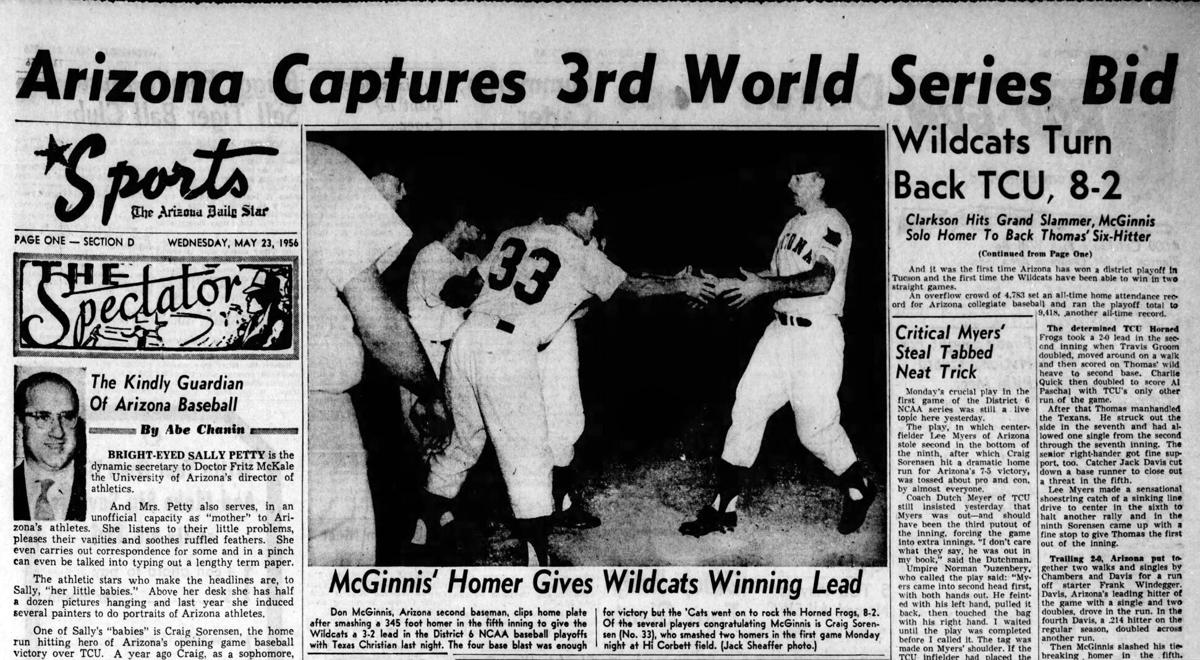Tucson was at the top of the list in the early 1950s when serious discussions began to find a permanent home for the College World Series.
The CWS, which began in 1947, had jumped from Kalamazoo, Michigan, to Wichita, Kansas, as the game started to gain traction.
In 1954, the Wildcats became the first college baseball team to win 40 games in a season, and although there was no official list of the game’s attendance leaders, it was believed Arizona, which sometimes drew 2,000 to its modest on-campus field in Tucson, was at the top.
UA officials believed night games at what is now Hi Corbett Field could draw 4,000 or more.

Unfortunately, with day games made necessary by the CWS’ double-elimination format, Arizona’s summer heat led CWS organizers to settle on Omaha, Nebraska, where it has continued uninterrupted from 1950-2022.
It didn’t stop Arizona’s rise as a national power.
From 1954-56, Arizona became the first team to qualify for three consecutive CWS, and its 1956 team, which set an NCAA record with 49 victories, was a strong threat to become the first national champion, in any sport, at the UA.
The origin of coach Frank Sancet’s 1956 team began innocently when he was a catcher for the Class-B Tampa Smokers in 1930. Sancet, a catcher, became friends with Tampa’s top pitcher, Thornton Lee, who would go on to pitch 16 years in the big leagues.
Thornton Lee’s son, Donnie, a right-handed pitcher who became a top prospect while pitching at Phoenix North High School, signed with Arizona after his high school days. Good timing.

Frank Sancet to UA to Omaha numerous times, but could never capture a national championship.
The Wildcats went 130-25 with Lee as the UA’s No. 1 pitcher. Lee was so dominant that today, 66 years after he made his last appearance as a Wildcat, he holds school career records for wins (36) and complete games (also 36).
Lee entered the 1956 World Series with a 13-0 record. His high school catcher from Phoenix, Jack Davis, was UA’s starting catcher on a team Sancet built around Arizona talent. Leadoff batter Tom Tomooka, a .368 hitting shortstop, and star outfielder Lee Myers were both from Tucson High School state championship teams. Third baseman Craig Sorensen, a .339 hitter, was from Yuma.
The big addition to the Arizona-loaded lineup was pitcher Carl Thomas, who had grown up in Minnesota but transferred to Arizona after a year at junior college. To this day, Lee and Thomas, remain the most imposing 1-2 pitching punch in UA history. Thomas finished his UA career with 35 victories, second only to Lee.
Once the Wildcats arrived in Omaha, Sancet had a difficult choice to make. He could save Lee and Thomas for what were likely to be more difficult games, against Minnesota and Ole Miss, or he could use one in an opener against lightly-regarded NYU.
Sancet opted to be safe. He used Lee in the opener. Lee shut out NYU, 3-0.
But opposing manager Dick Siebert of Minnesota held his ace, Jerry Thomas, out of the Gophers’ opening victory over Wyoming. It would turn out to be the biggest factor at the 1956 World Series.
A day later, Minnesota beat Carl Thomas and Arizona 3-1 behind the dominant Thomas.

The UA baseball team rode a powerful pitching staff to the 1956 national championship game.
Arizona was forced to play three elimination games the next three days, using Lee and Thomas to force a championship showdown against Minnesota. But in that game, the Gophers’ ace was fully rested while Lee and Thomas were spent.
Arizona started its No. 3 pitcher, Ernie Oosterveen, who was the losing pitcher in a 12-1 game.
Much has been made of the coincidence that Minnesota’s star player was shortstop Jerry Kindall, who would go on to play nine years in the big leagues and then replace Sancet as the UA’s baseball coach in 1972. Kindall had a good College World Series but only got three hits in the three games against Arizona.
It was the fully-rested pitcher, Thomas, who was named the CWS MVP.
Over the next 17 years, Sancet seemed sure to break through and finally win a national championship, but his powerful teams of 1958, 1959, 1960, 1963 and 1966 were similarly frustrated in Omaha. Sancet, who retired at the UA’s mandatory retirement age of 65 in 1972, went 831-272 in his UA career, but never finished higher than No. 2 in eight visits to the CWS. He died in 1985.
Lee and Thomas both became major-leaguers. Lee pitched nine seasons for the Tigers, Senators, Twins, Angels, Astros and Cubs and retired, still living in Tucson. Thomas pitched one year in MLB before leaving the game in 1962 to become a cement contractor in Phoenix. He died in 2013.








